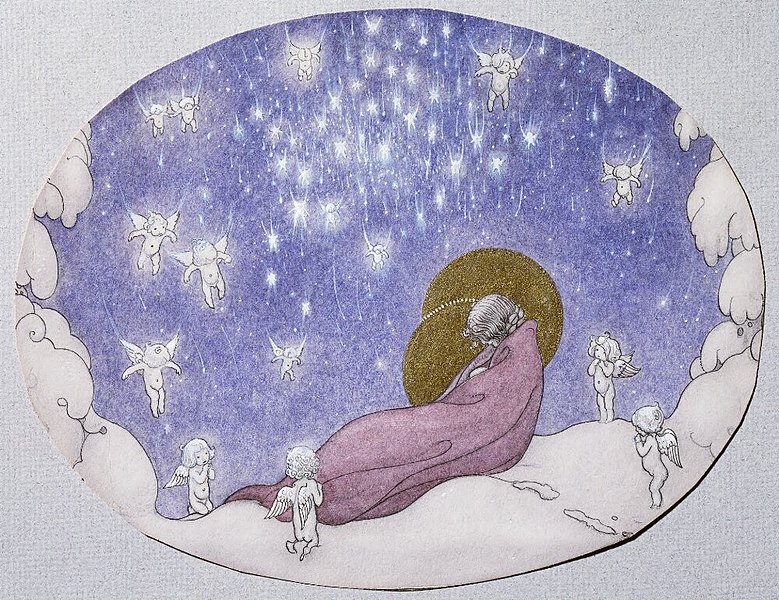26 Angels
Angels in Art, Poetry, and Related Texts
Seraphim, cherubim, ophanim, archangels, and myriad other angels that form angelic hierarchies have been depicted in art throughout the centuries. Common to Christianity, Islam, and Judaism, angels are portrayed as guardians of humankind. Angels accompany people as they embark on life’s journeys that are marked with triumphs and tragedies. They may protect, comfort, console, and inspire (Wilkinson, 1994). Angels are often connected with radiant light, the ability to soar to the heavens, and brilliant beauty. Angels convey a message that “goodness will prevail” and justice will eventually triumph over injustice. The wings of an angel “symbolize flight, the freedom of the skies and the power to bridge the gulf between God and man, heaven and earth” (Wilkinson, 1994, p. 6). The colours of an angel’s wings also have symbolic meaning; ruby wings suggest love while blue wings may symbolize divine wisdom. Angels possess a “life-affirming” light that can guide and protect individuals who are struggling through hardships of loss, death, and emotional devastation. Angels painted by the great early Renaissance artist Giotto reveal deep emotional intensity as if the angels are empathizing and experiencing the pain and sadness of the individual. For Renaissance and Baroque artists, resembled the wings of beautiful birds such as peacocks and swans In her book Angels in Art, Belinda Wilkinson (1994) writes:
“Angels have been portrayed by artists and writers the winged and radiant messengers of God, who fly between heaven and earth, mediating between God and man. In the Purgatorio, Dante describes them as the bright birds of God, indicating their heavenly role and nature. In art, too, angels appear with the wings of a bird, but with the figure of a perfect man… Angels first appear in fourth-century Byzantine art. Wholly Greek in origin, they recall the flying deities of the Classical world. By the fifth century, radiant nimbi (haloes) surround angels’ heads creating an archetypal image which has survived in the present day. Their beauty is, inevitably, expressed in human terms and in contemporary styles of art. Angelic faces are typically radiant, youthful and serene, while graceful figures are clad in robes that are often Classical, though sometimes priestly and fashionable. Early Byzantine angels are still and gracious with the grave and serious air of their Greek models. By the Middle Ages they have become ethereal and immaterial, often disappearing in a whirl of robes or melting into cloud. Fluid and expressive, Gothic angels sometimes share in the human drama, as do Giotto’s distracted spirits. Those of the Renaissance, such as Melozzo’ Gabriel or Botticelli’s choirs reach a peak of sublime grace perhaps never seen again. During the Baroque era, many angels emerge as fresh and candid infants or cherub….The dreamy Italianate creations of the Pre-Raphaelites revive some aspects of the Renaissance, while many modern angels recall the simplicity and spirituality of earliest portrayals.” (Wilkinson, Angels in art, 1994, Introduction pp. 6-7).
As you explore this section, identify some of the angel images that are interesting and meaningful to you. Try to learn more about the artist, and research the way art is a mirror that synthesizes salient cultural, social, psychological, and historical events.
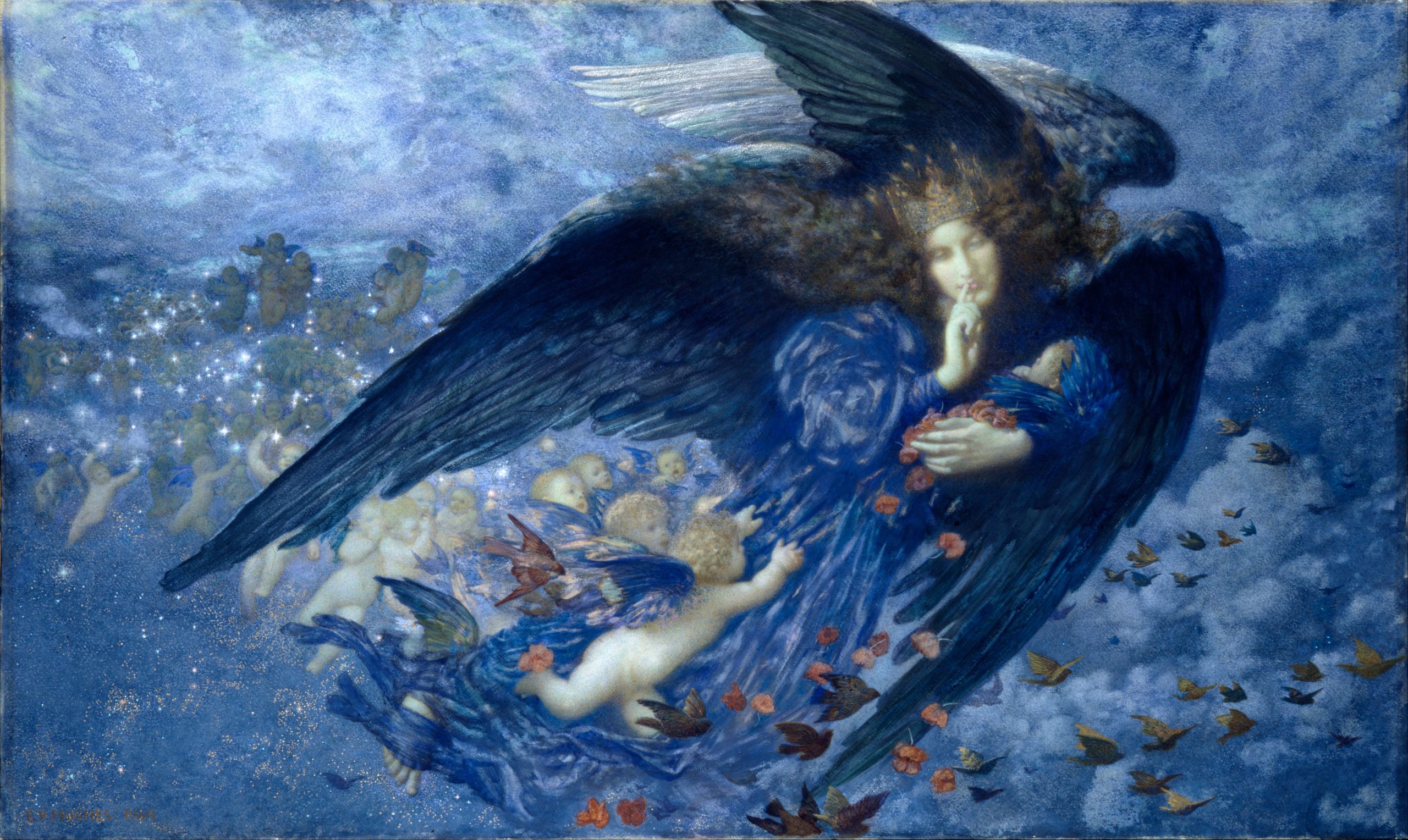
“Margaritae Sorori” by W.E. Henley (1849-1903)
A little lark twitters from the quiet skies:
And from the west,
Where the sun, his day’s work ended,
Lingers as in content,
There falls on the old, gray city
An influence luminous and serene,
A shining peace.
The smoke ascends
In a rosy-and-golden haze. The spires
Shine and are changed. In the valley
Shadows rise. The lark sings on. The sun,
Closing his benediction,
Sinks, and the darkening air
Thrills with a sense of the triumphing night
Night with her train of stars
And her great gift of sleep.
So be my passing!
My task accomplish’d and the long day done,
My wages taken, and in my heart
Some late lark singing,
Let me be gather’d to the quiet west,
The sundown splendid and serene,
Death.
Retrieved All Poetry Website: https://allpoetry.com/Margaritae-Sorori
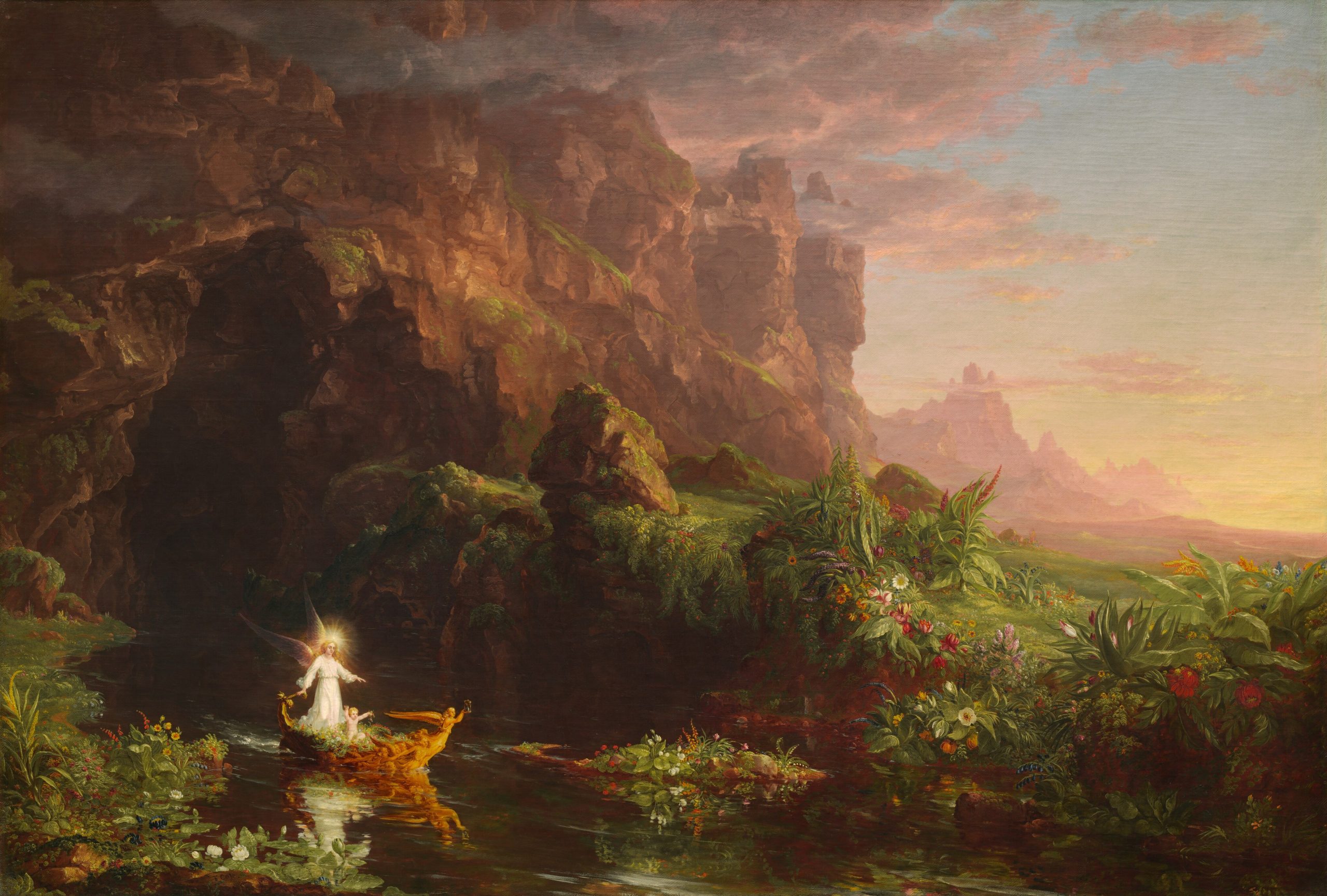
National Gallery of Art Note:
“Thomas Cole’s renowned four-part series traces the journey of an archetypal hero along the “River of Life.” Confidently assuming control of his destiny and oblivious to the dangers that await him, the voyager boldly strives to reach an aerial castle, emblematic of the daydreams of “Youth” and its aspirations for glory and fame. As the traveler approaches his goal, the ever-more-turbulent stream deviates from its course and relentlessly carries him toward the next picture in the series, where nature’s fury, evil demons, and self-doubt will threaten his very existence. Only prayer, Cole suggests, can save the voyager from a dark and tragic fate. From the innocence of childhood, to the flush of youthful overconfidence, through the trials and tribulations of middle age, to the hero’s triumphant salvation, The Voyage of Life seems intrinsically linked to the Christian doctrine of death and resurrection. Cole’s intrepid voyager also may be read as a personification of America, itself at an adolescent stage of development. The artist may have been issuing a dire warning to those caught up in the feverish quest for Manifest Destiny: that unbridled westward expansion and industrialization would have tragic consequences for both man and nature.” National Gallery, Washington. https://www.nga.gov/collection/highlights/cole-the-voyage-of-life-childhood.html
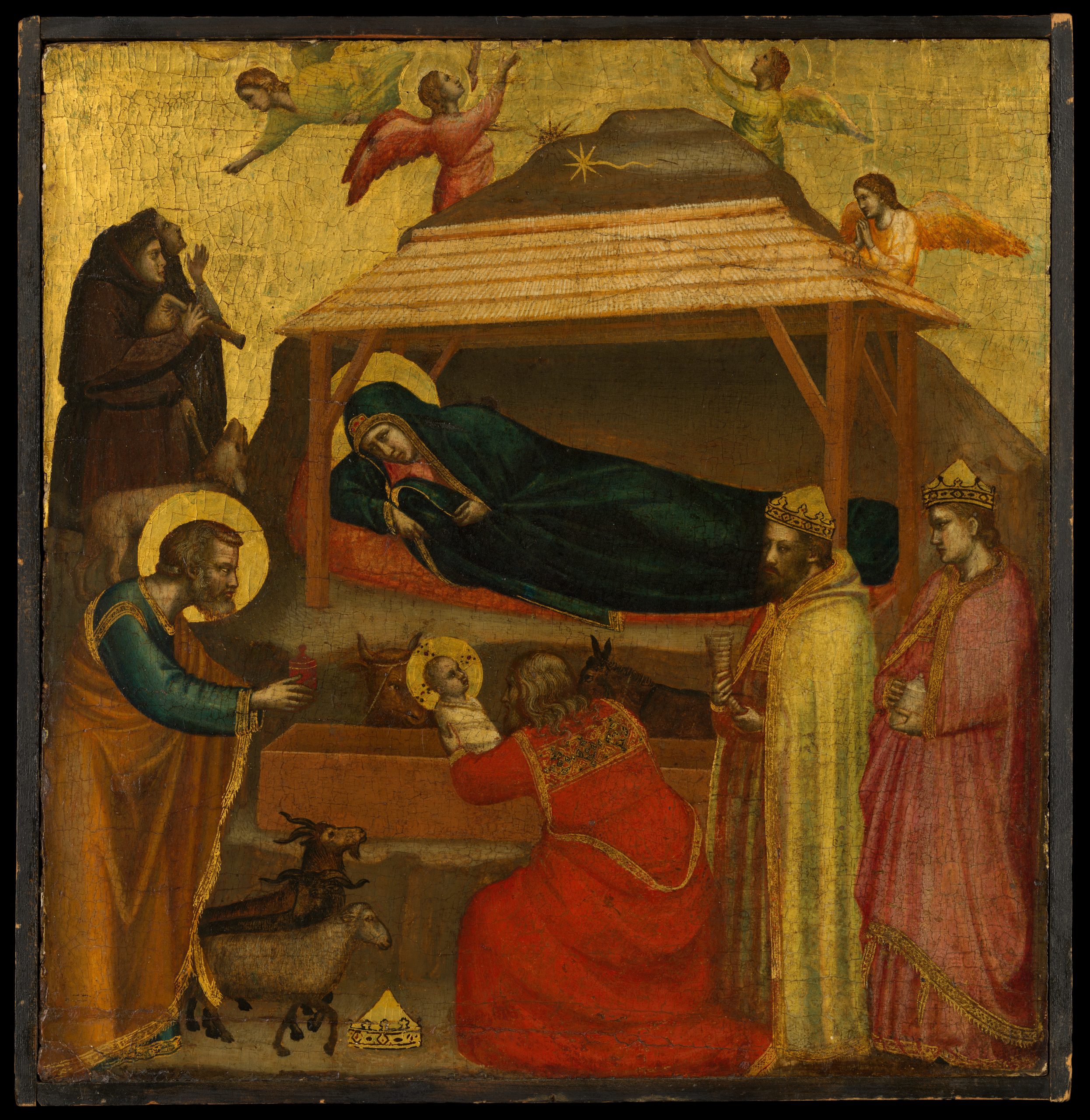
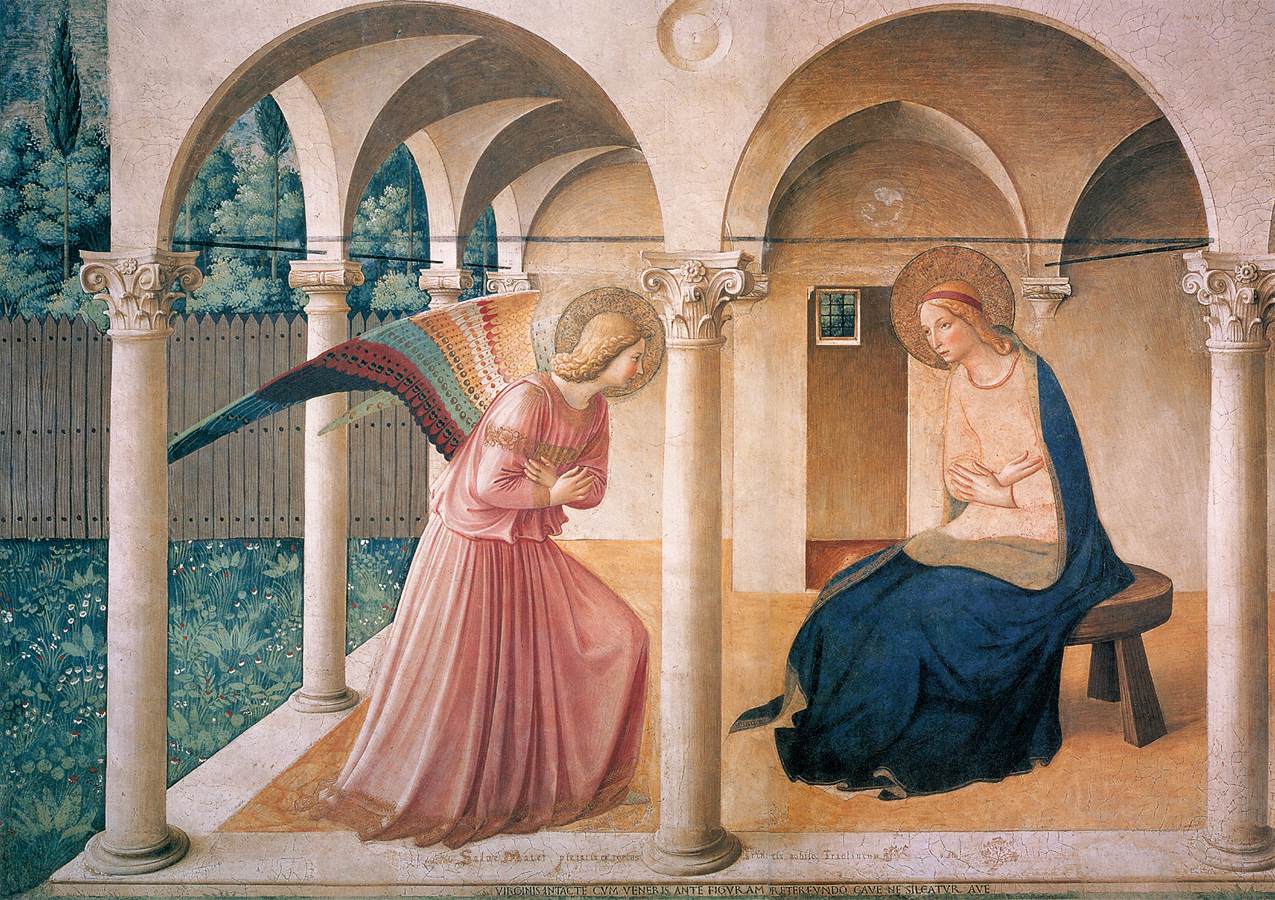
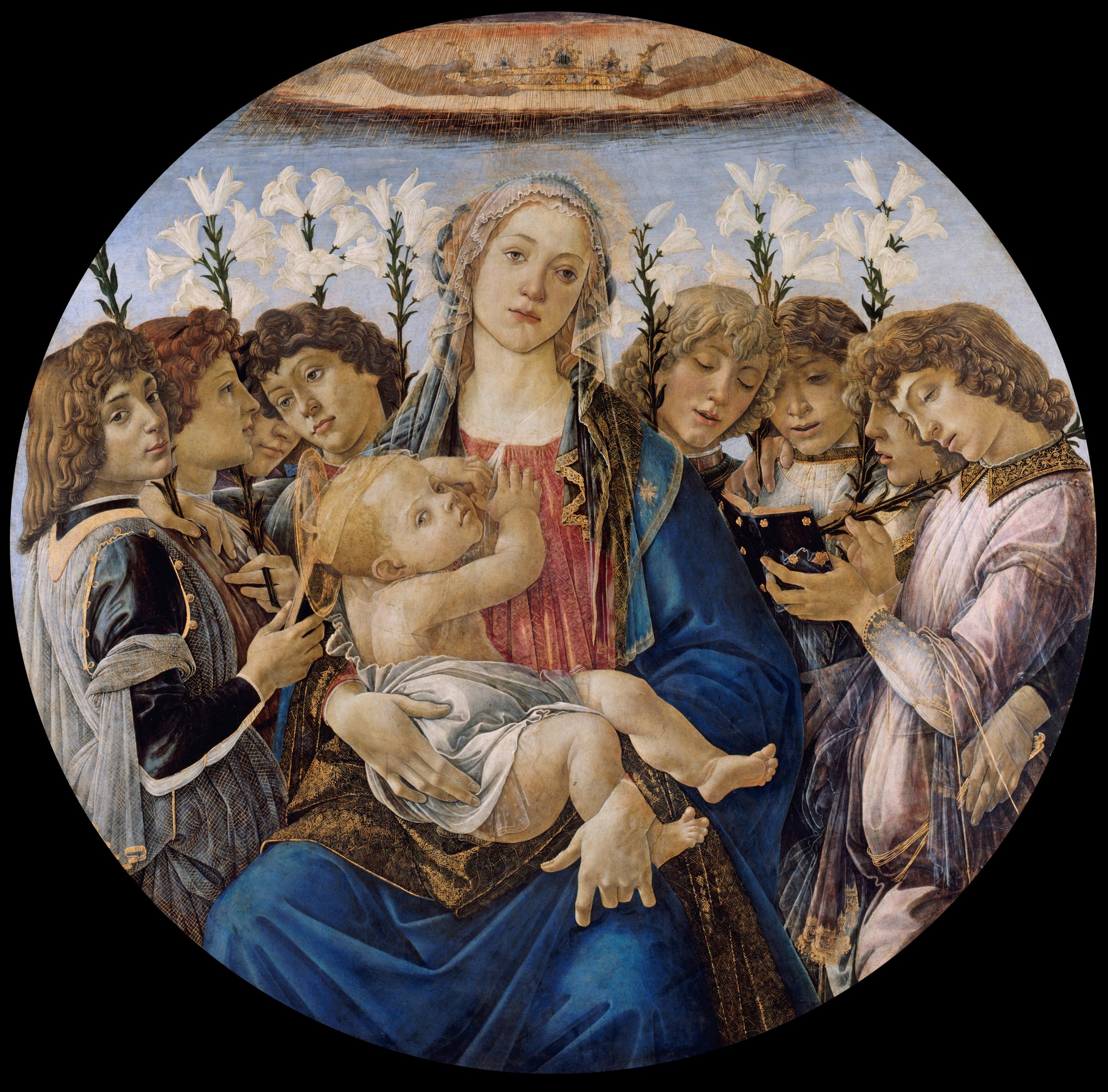
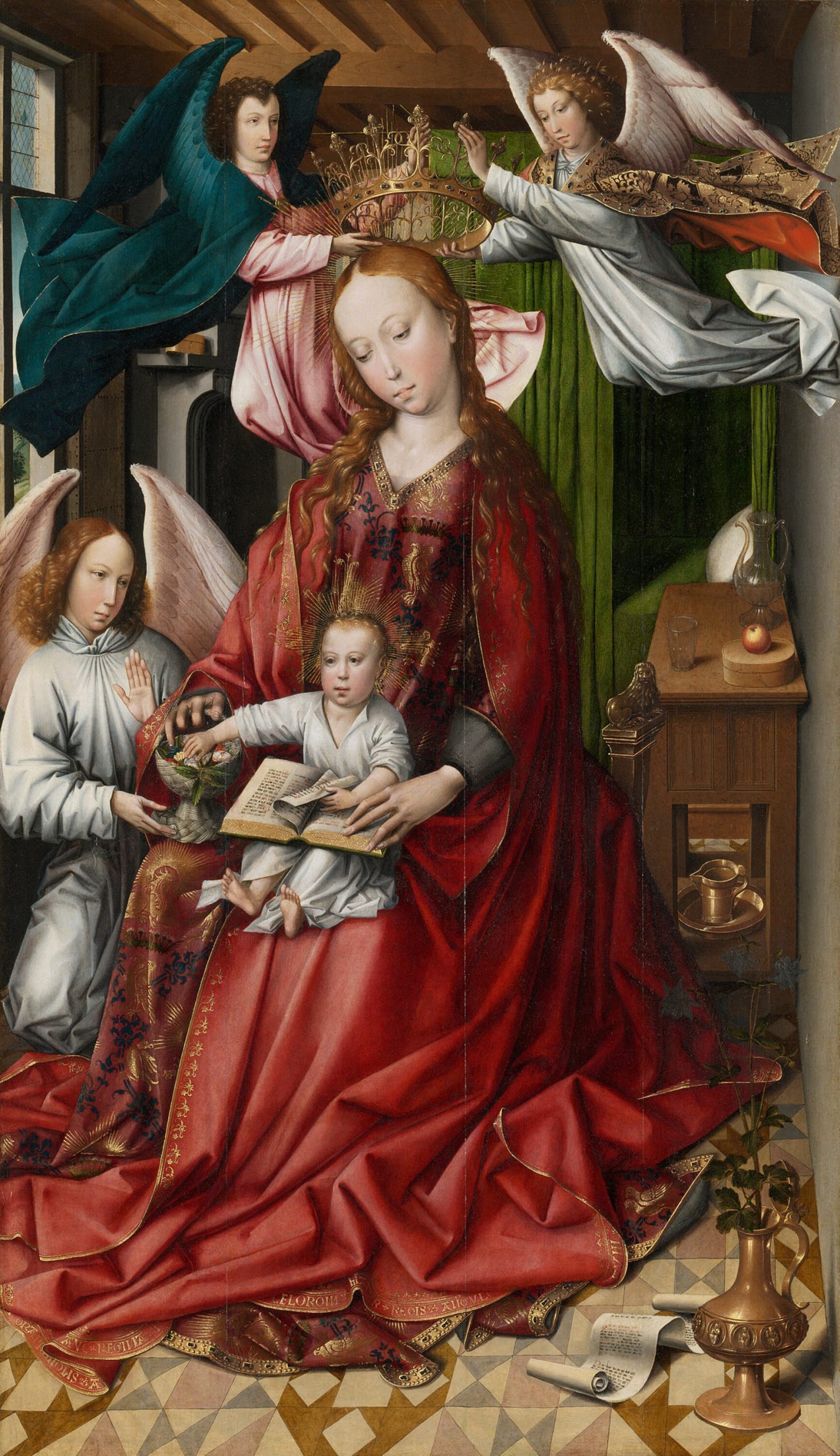
Fra Angelico (1395-1455), The Annunciation, 1438-1450. Museum of San Marco, Florence, Italy. “https://commons.wikimedia.org/wiki/File:ANGELICO,_Fra_Annunciation,_1437-46_(2236990916).jpg” by Carulmare Angelico is licensed under CC BY 2.0.

“This Annunciation is exceptional for its bird’s-eye view and outdoor setting. Sheltered in the doorway of a church and greeted by Gabriel, Mary is presented not only as the recipient of the message of the Incarnation, but also as the personification of the Church (Ecclesia). The architecture, which is part Romanesque (right) and part Gothic (left), refers to the coming of Christ and the transition from Judaism to Christianity. A fragment of a larger composition, the picture is notable for its meticulous observation of plant life and was formerly ascribed to Van Eyck.” Retrieved October 6, 2022 https://www.metmuseum.org/art/collection/search/435899
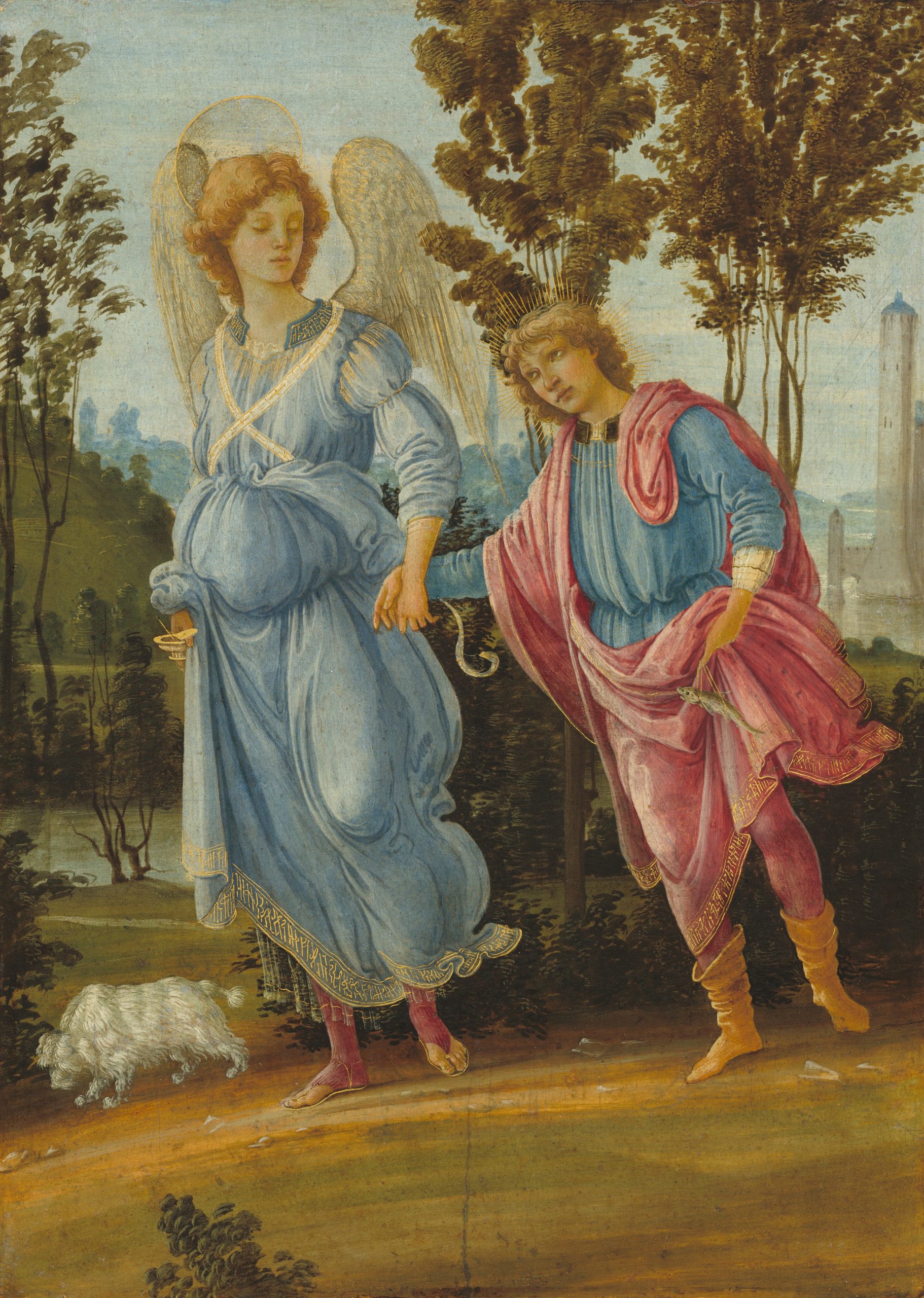
Quotations about Angels from the Plays of William Shakespeare (1564-1616)
“What a piece of work is man, how noble in reason, how infinite in faculty, in form and moving how express and admirable, In action how like an Angel, In apprehension how like a god, The beauty of the world, The paragon of animals. And yet to me, what is this quintessence of dust?” -Hamlet, Act 2, scene 2.
-“Good night, sweet prince and flights of angels sing thee to thy rest—” (Hamlet Act 5, Scene 2).
“Angels are bright still, though the brightest fell.” (Act 4, Scene 3, Macbeth).
–“O, speak again, bright angel! for thou art as glorious to this night, being o’er my head as is a winged messenger of heaven“ -Romeo and Juliet, Act 2, scene2, William Shakespeare.
– “A ministering angle shall my sister be.” (Hamlet, Act 5, scene 1, William Shakespeare, 1564-1616 )
“We all are men, in our own natures frail, and capable of our flesh; few are angels.”- Henry VIII, Act 5, scene 3, William Shakespeare.
Sources:
The Project Gutenberg eBook of The Complete Plays of William Shakespeare
https://www.gutenberg.org/cache/epub/100/pg100-images.html
https://www.azquotes.com/author/13382-William_Shakespeare/tag/angel
Project Gutenberg eBook of The Sonnets by William Shakespeare:
https://www.gutenberg.org/cache/epub/1041/pg1041-images.html
Angels in Art (Wikipedia)
https://en.wikipedia.org/wiki/Angels_in_art
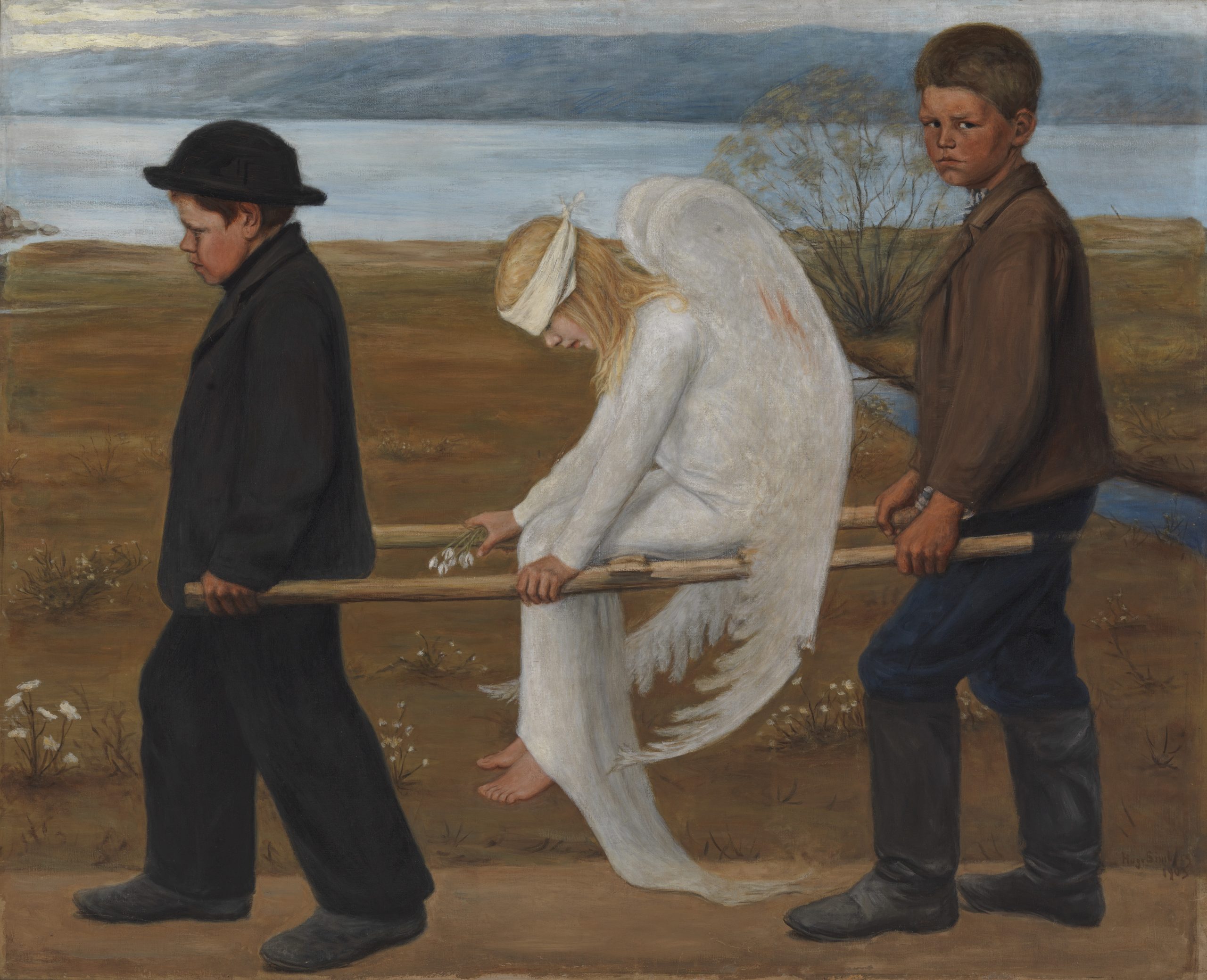
The Wounded Angel by Finnish artist Hugo Simberg (1873-1917)
This powerful painting by the Finnish artist Hugo Simberg can be viewed as a symbol of healing, hope, and compassion. At one level, the painting might represent the artist’s own arduous journey of healing from meningitis. At another level, the painting might also represent the suffering and pain of the Finnish people who endured centuries of occupation under Swedish and then Russian rule. It is as if the angel has internalized the suffering of the people and is helped to safety by the two boys. Simberg stated that his painting is open to interpretation. In their book about the myths and legends of Finland, Kirsti Makinen and Pirkko-Liisa Surojegin (2001) explain the unique art, culture, and language of Finland had been negated over long periods of domination by Sweden (since the 1300s) and by Russia (from 1809-1917). After declaring independence in 1917, Finnish art, literature, and language experienced a resurgence. Compiled from thousands of Finnish folk tales, ballads, and poems by the Finnish doctor, linguist, and poetry enthusiast Dr. Elias Lönnrot, the epic poem The Kalevala became a cornerstone of Finnish culture. Artists like Akseli Gallen-Kallela (1865-1931). Ilmari Aalto (1891-1934) and Hugo Simberg produced unique Finnish works that gave expression to the experiences of the Finnish people and to the geographical terrain. In 1906, the Ateneum Art Museum (the National Gallery of Finland) voted” The Wounded Angel” as Finland’s “national painting.” The landscape would also have been familiar to many Finnish people living in Helsinki. The district of Eläintarha with Töölönlahti Bay is in the background.
Additional Resources for more information about “The Wounded Angel” and the artist Hugo Simberg
https://en.wikipedia.org/wiki/The_Wounded_Angel
Source: Retrieved October 6, 2022 from
https://en.wikipedia.org/wiki/The_Wounded_Angel
Retrieved October 6, 2022
https://www.dailyartmagazine.com/wounded-angel-by-hugo-simberg/
Makinen, K., & Surojegin, P.L. (2001). The illustrated Kalevala: Myths and legends from Finland. Floris Books.
The Kalevala (The Epic Poem of Finland). Internet Archive
https://ia800301.us.archive.org/29/items/kalevalaepicpoe00unkngoog/kalevalaepicpoe00unkngoog.pdf
English Translation of The Kalevala (1898). The Public Domain Review https://publicdomainreview.org/collection/kalevala
Retrieved from All Poetry, October 7, 2022
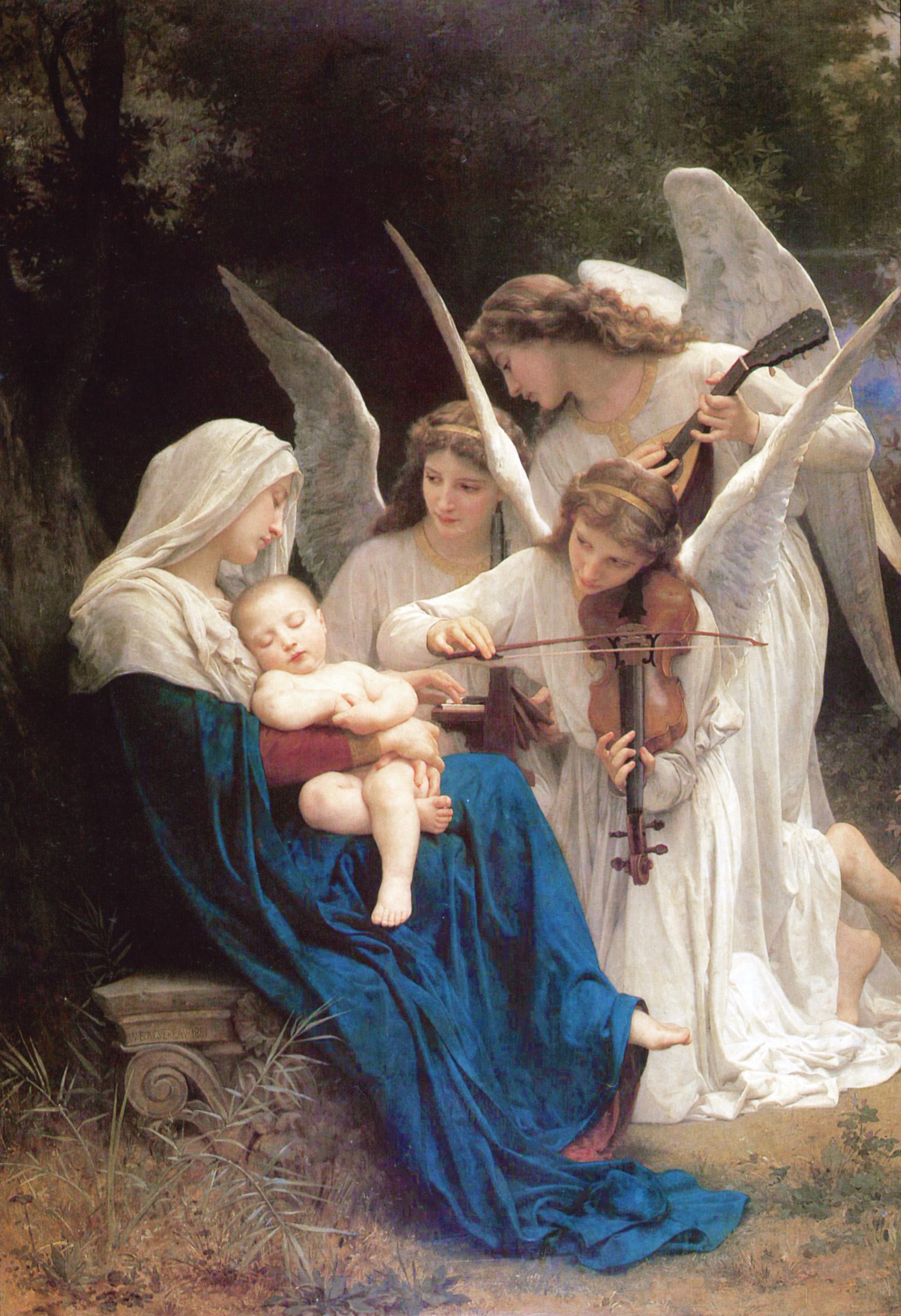
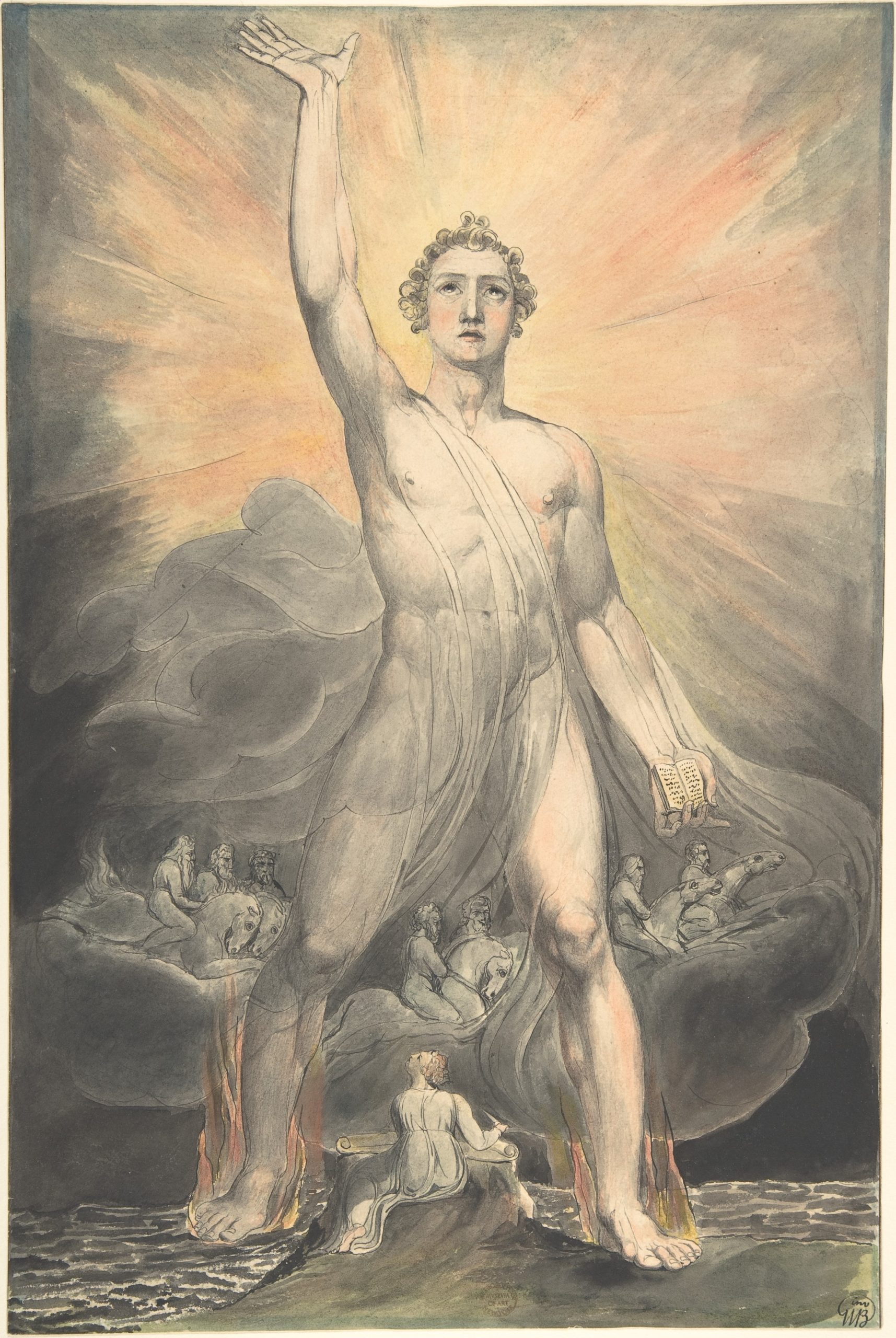
Courtesy: Rogers Fund, 1914. “https://www.metmuseum.org/art/collection/search/340852” is licensed under CC0 1.0.
I heard an angel singing by William Blake (1757-1827)
“I heard an Angel singing
When the day was springing,
“Mercy, Pity, Peace
Is the world’s release.”
Thus he sung all day
Over the new mown hay,
Till the sun went down
And haycocks looked brown.
I heard a Devil curse
Over the heath and the furze,
“Mercy could be no more,
If there was nobody poor,
And pity no more could be,
If all were as happy as we.”
At his curse the sun went down,
And the heavens gave a frown.
Down pour’d the heavy rain
Over the new reap’d grain…
And Miseries’ increase
Is Mercy, Pity, Peace.”
Retrieved August 3, 2023. The Poetry Foundation Website:
https://www.poetryfoundation.org/poems/43663/i-heard-an-angel
To read more about the artistry of William Blake and his influence on contemporary art and literature please open the Daily Art magazines in the link below.
https://www.dailyartmagazine.com/tag/william-blake/
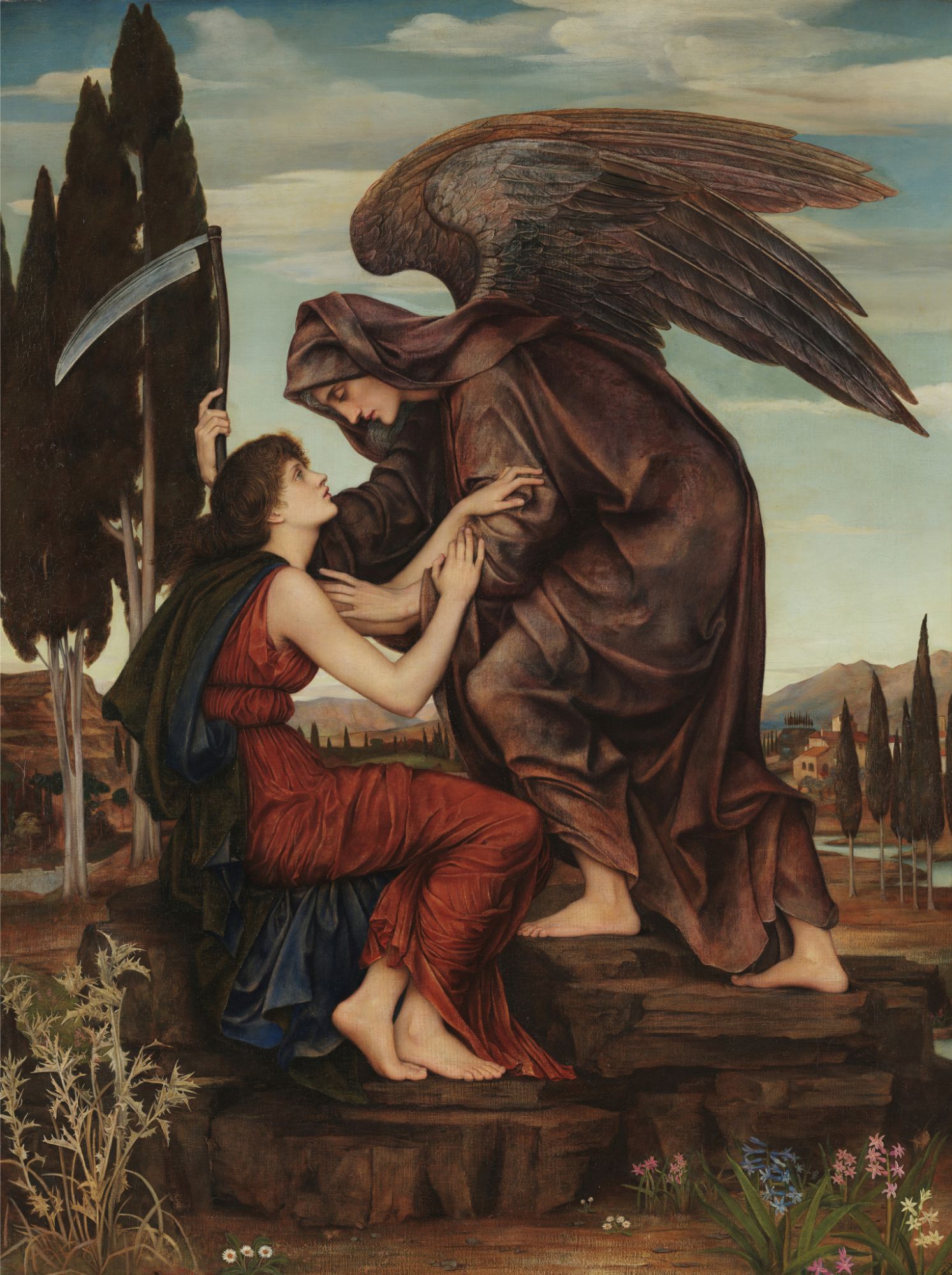
Symbolism in Art and Literature (Nathalia Brodskaia, Symbolism. Parkstone Press, 2007).
“Listing the qualities in symbolism, Remy de Gourmont first of all names individualism, creative freedom, the renunciation of studies formulae, the aspiration for everything new, unusual, even strange. ‘Symbolism…is nothing else than the expression artistic individualism’” (p. 33).“ A work of art connected to the ideas of Symbolism cannot be an object of calm, objective reading or contemplation. Alfred de Musset wrote that Romanticism was everything that agitates and disturbs the soul—and the same can be said of Symbolism. Only in Symbolism there is also the presence of strangeness, and mystery, and the sensation of the other-worldly, and fear, and the feeling of doom..” (Brodskaia, 2007, p.105.).
“The Cup” by Gustave Kahn (1859-1936)
In this cup of onyx
Clawed of its eboy by a chimaera
The ephemeral wave of the Styx
Passes and runs out toward the sea.
The sea sinks where the green veils
Of hopes are broken down
In the Bonnasse with the fingers inane;
The sky yawns like open wound
Red droplets in the cup of onyx
Fall and are washed out
And the black dream only shows its face
At the bottom of he cup, and its glance fixed.
-Gustave Kahn (1859-1936)
Source: Brodskaia, N. (2007). Symbolism, p. 59. Parkstone Press.
Internet Archive Collected poems of Gustave Kahn. https://archive.org/details/premierspomes00kahngoog/page/n18/mode/2up
https://www.poemhunter.com/gustave-kahn/
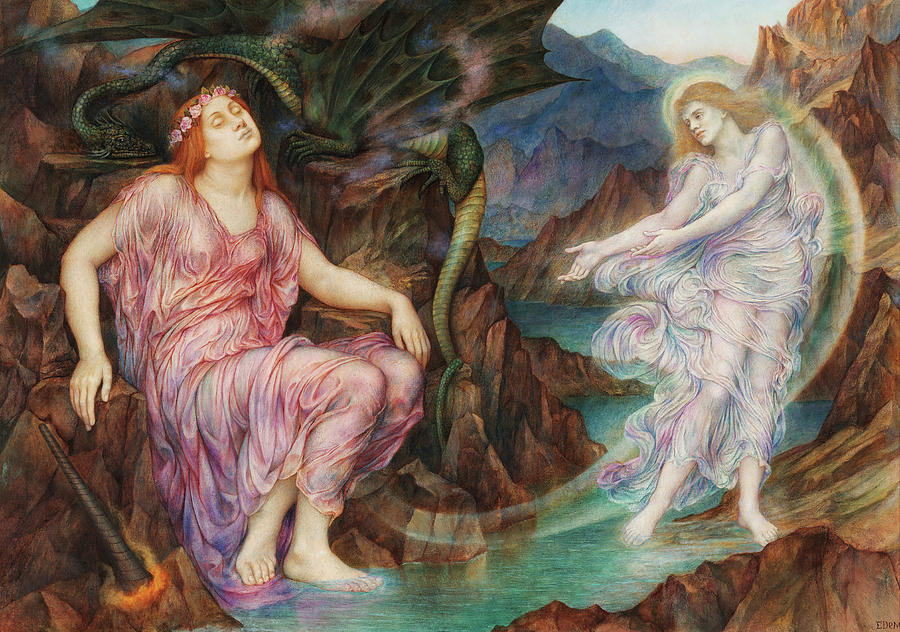

For more information about the Symbolist work of Elihu Vedder please open the link below.
https://americanart.si.edu/artist/elihu-vedder-5138
Evelyne De Morgan (1855-1919)-The Pre-Raphaelites, Aesthetic Art, Symbolism
“Art is eternal but life i s short. I do not have n a moment to lose.”-Evelyne De Morgan (1855-1919)
To learn more about the work of the artist Evelyne De Morgan, please open the links below.
https://www.theartstory.org/artist/de-morgan-evelyn/
Pre-Raphaelite Sisters: Five Artists You Need to Know
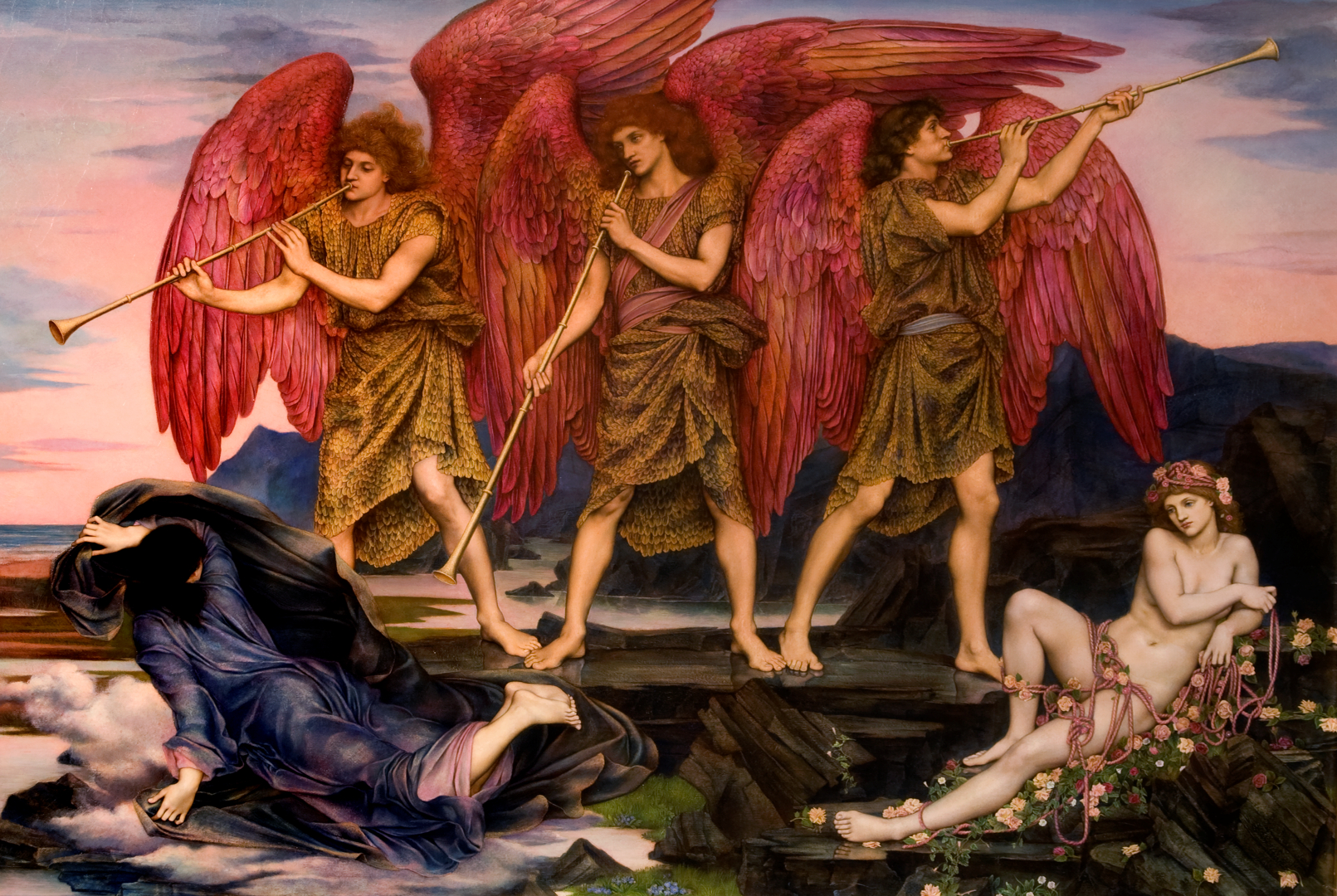
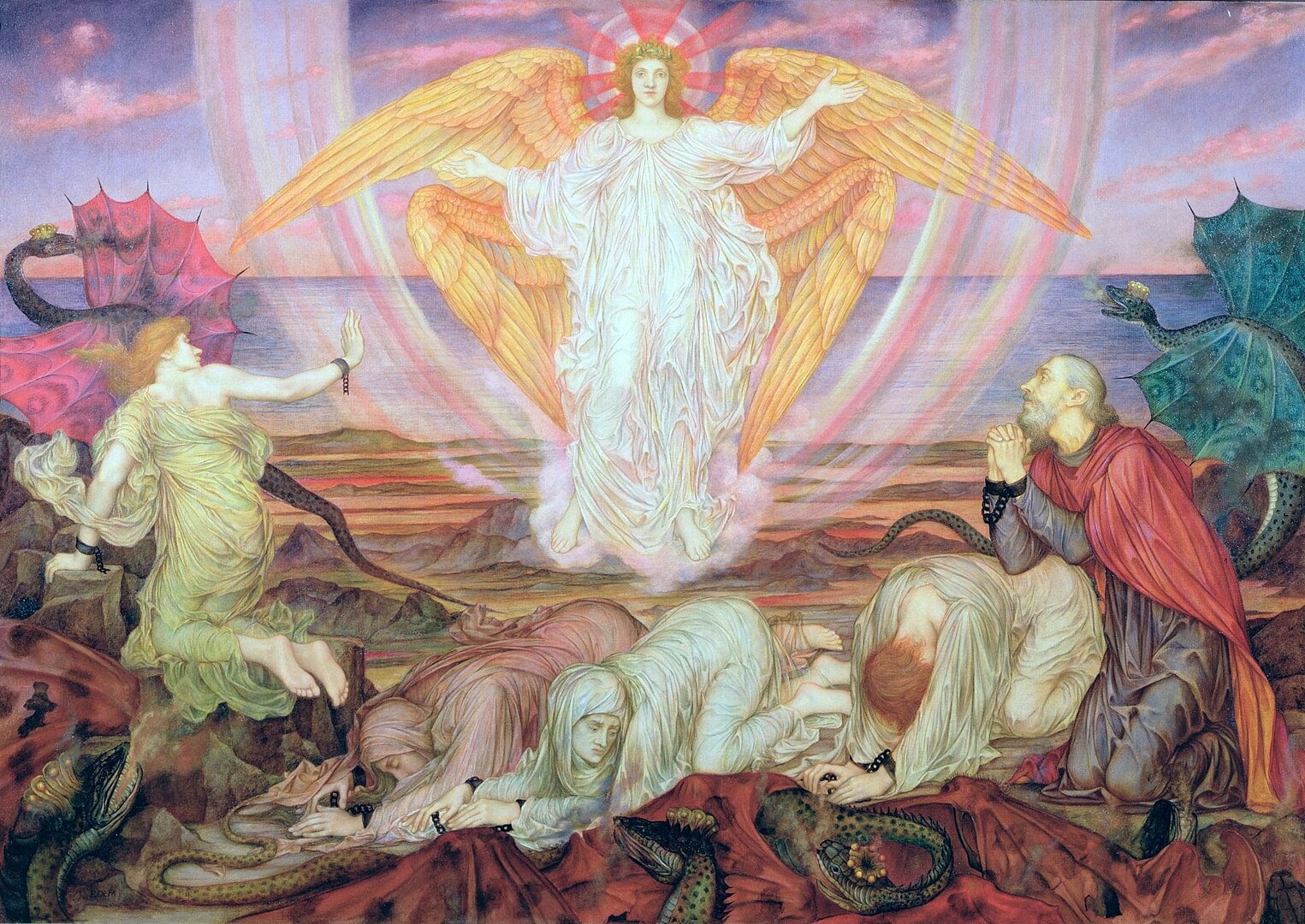
The Pre-Raphaelite Sister, Eveylyne De Morgan.
https://www.dailyartmagazine.com/evelyn-de-morgan-the-pre-raphaelite-sister-you-may-not-know/
The Angels of Abbott Handerson Thayer (1849-1921).
The American artist Abbott Handerson Thayer painted many angels. To Thayer, angels represented the realm of the mysterious and spiritual. His visionary angels were commentaries about the nature of love, life, death, salvation, and redemption. Some of the girls and women depicted as angels in Thayer’s paintings were his daughter and beloved wife who died tragically. Angels are often associated with the positive and idealized dimensions of human nature: kindness, compassion, and unconditional love. Angels are intermediaries between the divine and human worlds.
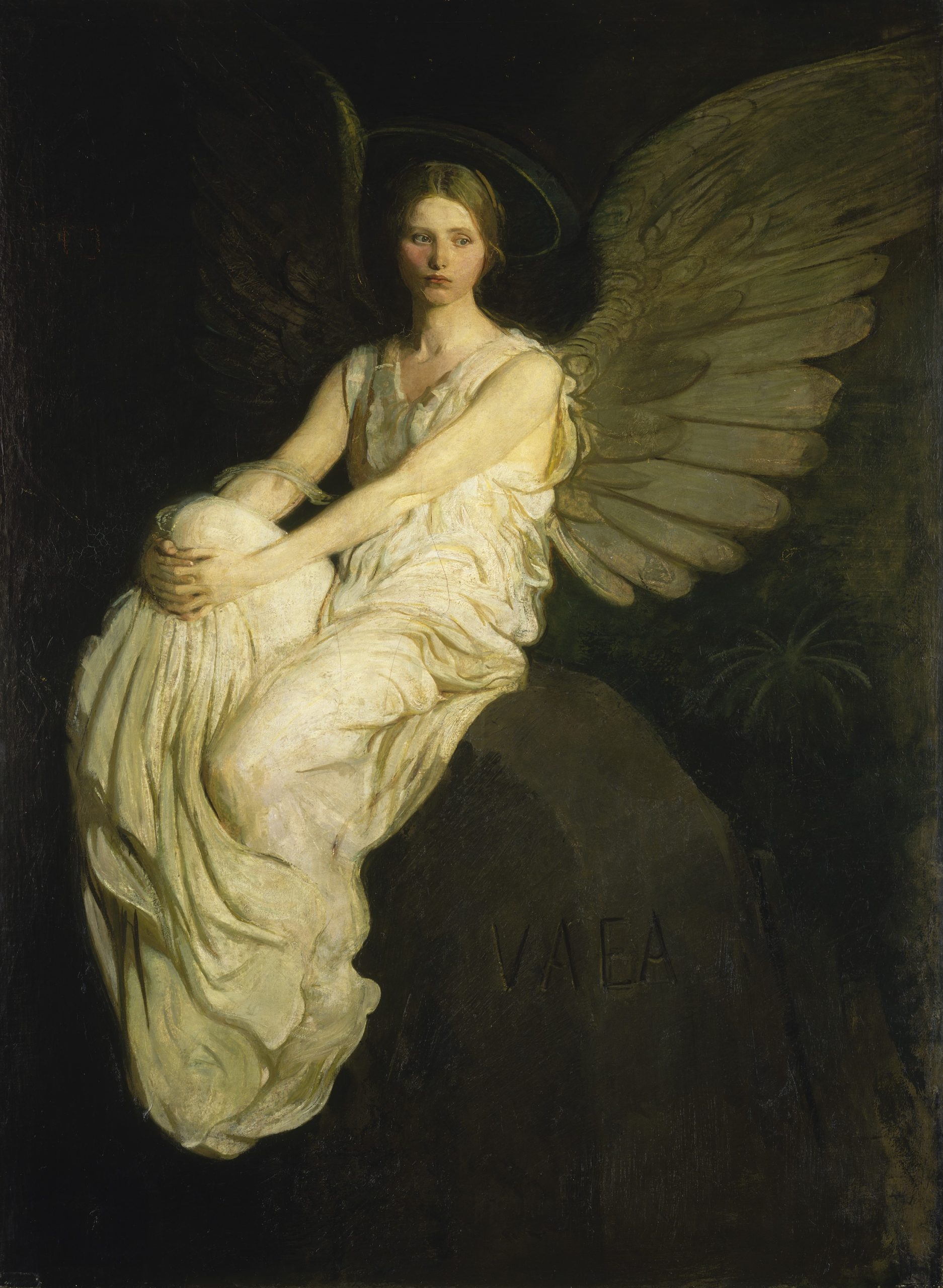
The Hidden Story Behind the Stevenson Memorial Angel
Abbot Handerson Thayer’s life was juxtaposed with experiences of joy and tragedy. In this image, an angel is guarding over the gravesite of Scottish writer Robert Louis Stevenson. Stevenson was buried in Samoa; Thayer connected with Stevenson’s struggles in life. Thayer’s wife died in 1891 and through his art, Thayer comments on the fate, the mysteries of life and death, and the strength of the spirit. This painting carriers a secret story. Underneath this painting, Thayer had painted his three children as a tribute to Stevenson’s Child’s Garden of Verses. Thayer’s angels hope, memory, and light in times of despair. Thayer’s angels have a gravity of expression; they seem to personify virtues such as strength, compassion, and love. (Adapted from October 11, 2022 https://americanart.si.edu/artwork/stevenson-memorial-23951
” The Angel” by William Blake (1757-1827)
I dreamt a dream! What can it mean?
And that I was a maiden Queen
Guarded by an Angel mild:
Witless woe was ne’er beguiled!
And I wept both night and day,
And he wiped my tears away;
And I wept both day and night,
And hid from him my heart’s delight.
So he took his wings, and fled;
Then the morn blushed rosy red.
I dried my tears, and armed my fears
With ten-thousand shields and spears.
Soon my Angel came again;
I was armed, he came in vain;
For the time of youth was fled,
And grey hairs were on my head.
-William Blake.
https://allpoetry.com/poem/8437971-The-Angel-by-William-Blake
Collected Poems of William Blake: Internet Archive. https://archive.org/details/70TheBookOfThel
Retrieved October 6, 2022 https://www.gutenberg.org/cache/epub/574/pg574.html
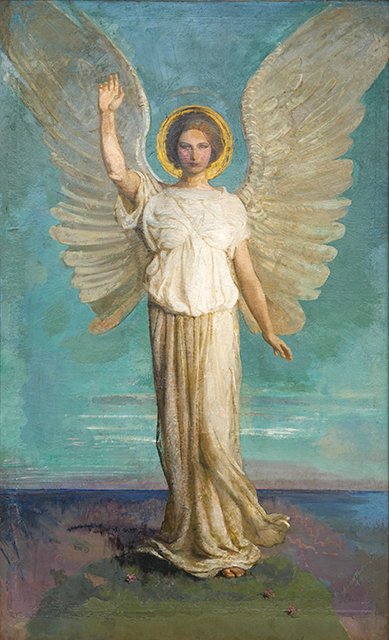
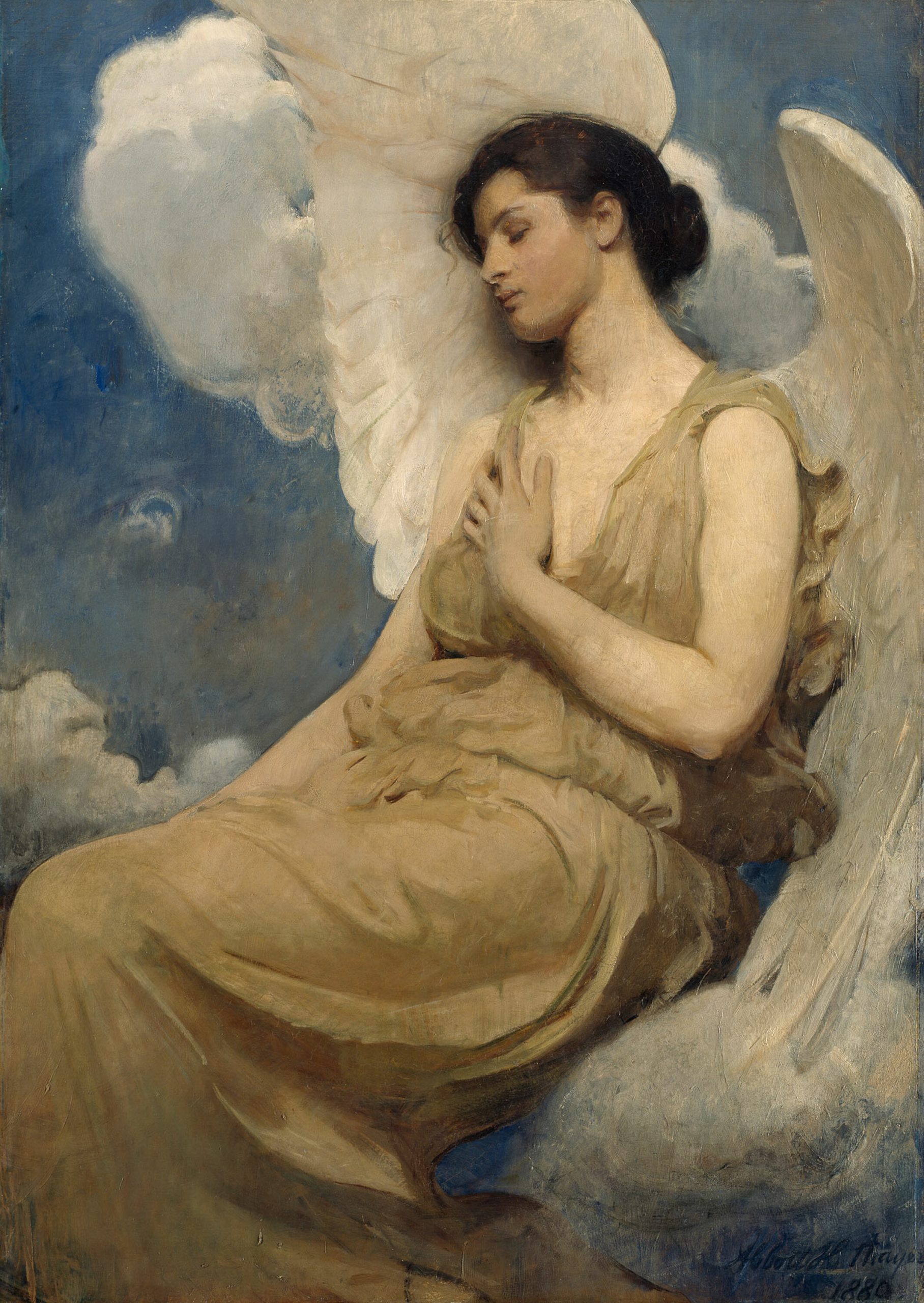
For more information about the artist please open the link below.
https://en.wikipedia.org/wiki/Abbott_Handerson_Thayer
For more information about angels in paintings please open the link below./
Angel in the House by Leigh Hunt (1784-1859)
How sweet it were, if without feeble fright,
Or dying of the dreadful beauteous sight,
An angel came to us, and we could bear
To see him issue from the silent air
At evening in our room, and bend on ours
His divine eyes, and bring us from his bowers
News of dear friends, and children who have never
Been dead indeed, —as we shall know forever.
Alas! we think not what we daily see
About our hearths, —angels that are to be,
Or may be if they will, and we prepare
Their souls and ours to meet in happy air;—
A child, a friend, a wife whose soft heart sings
In unison with ours, breeding its future wings
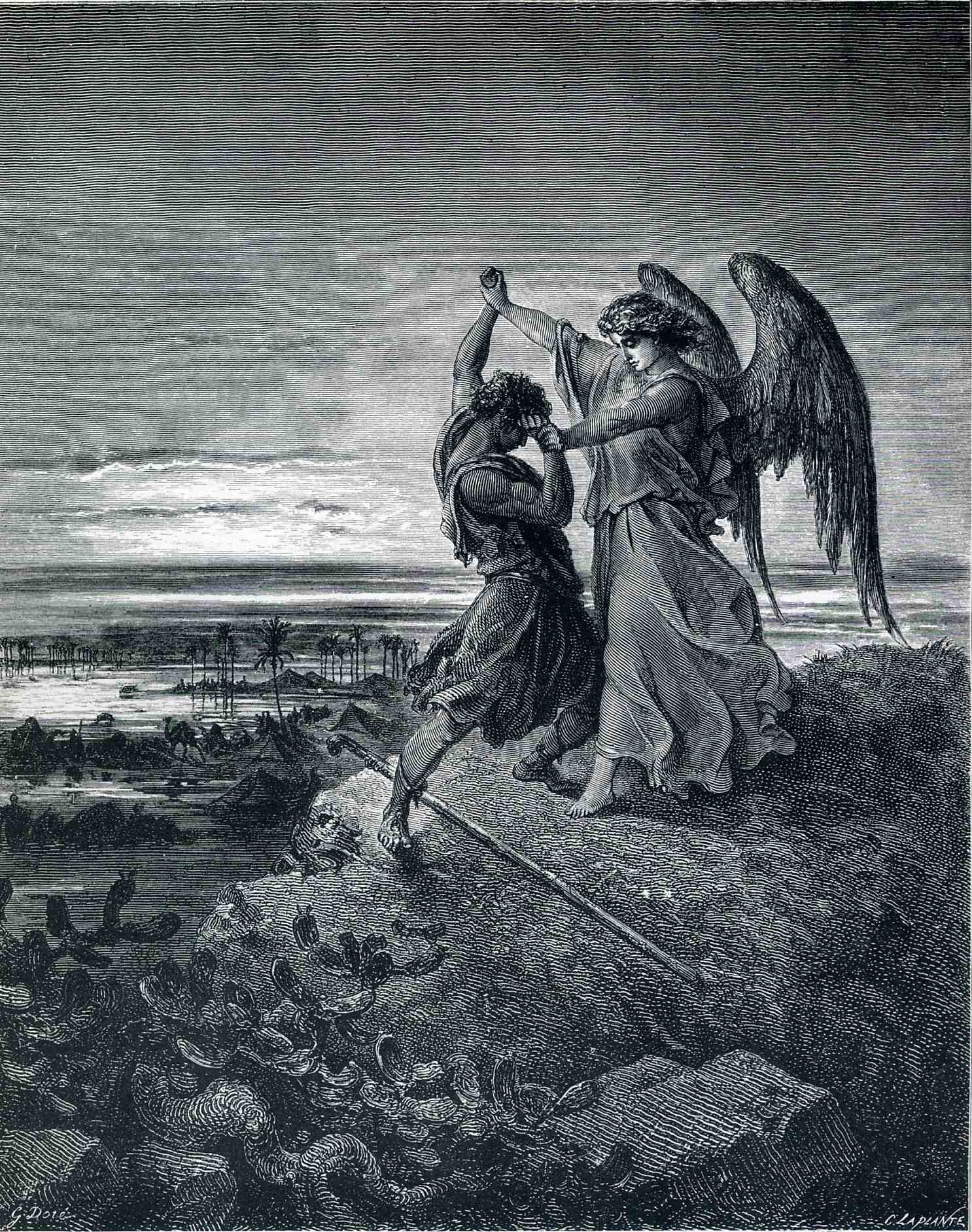
Jacob Wrestling with the Angel by Gustave Doré
The conflict between Jacob and the angel can be viewed as a metaphor for the struggle between good and evil and the struggle that individuals have with their own darker nature. The struggle for justice amid suffering and injustice is another theme that emerges from Gustav Dore’s etching. “In sore conflict she (the angel) gave him the victory, that he might know that goodness is stronger than all.” (Wisdom, 10:12).
https://arthistoryproject.com/artists/gustave-dore/jacob-wrestling-with-the-angel/
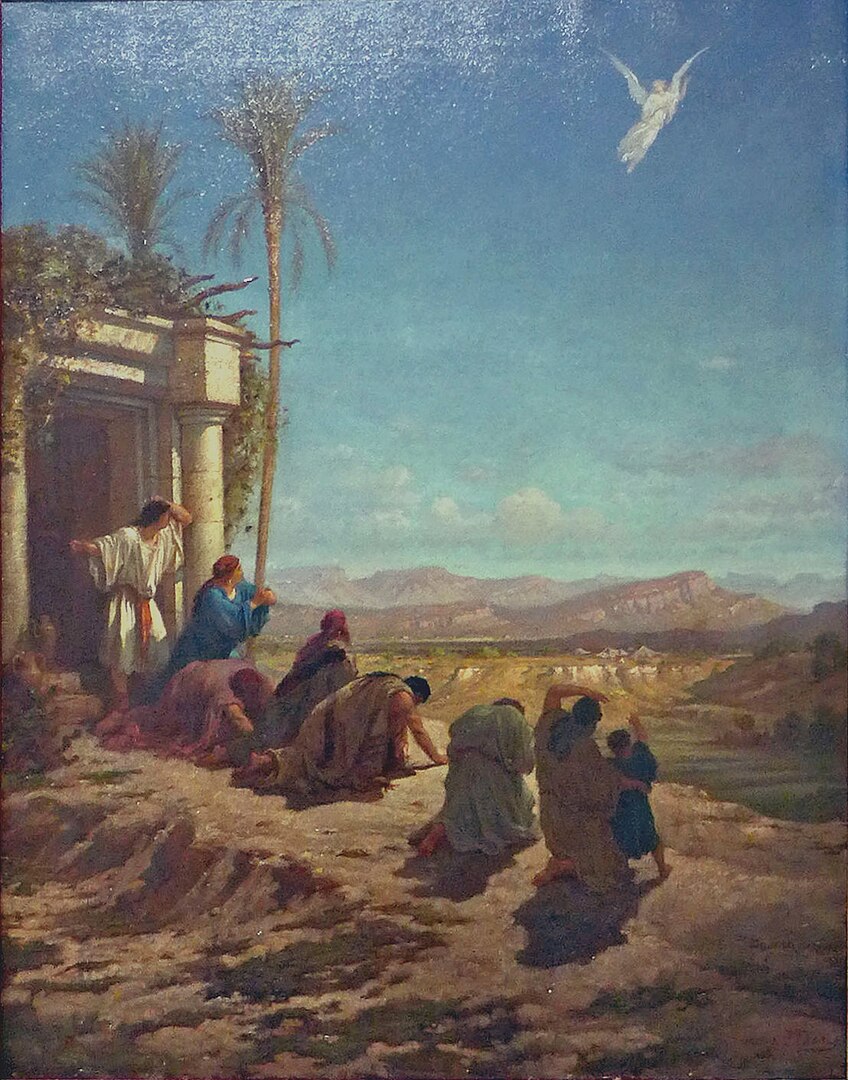
Franz Dvorak (1862-1927) Angel of the Birds. 1910.
https://upload.wikimedia.org/wikipedia/commons/f/f6/Dvorak_angel.jpg
Dahesh Gallery, New York City, Curator Notes
“The Angel of Birds reveals the diverse influences of the Pre-Raphaelites, Aesthetic Movement, and fairy painting—as well as Dvorak’s interest in nature and the imaginary. Diverse birds, their individual characteristics carefully depicted, surround the central, angelic figure. Their vibrant, almost otherworldly colors are mirrored in her expansive wings, a dazzling effect reminiscent of William Holman Hunt’s late work, The Lady of Shalott (c. 1890–1905, Wadsworth Athenaeum).” (Retrieved March 28, 2023https://www.daheshmuseum.org/portfolio/franz-dvorak-the-angel-of-the-birds/#.ZCMVYcrMI2w)
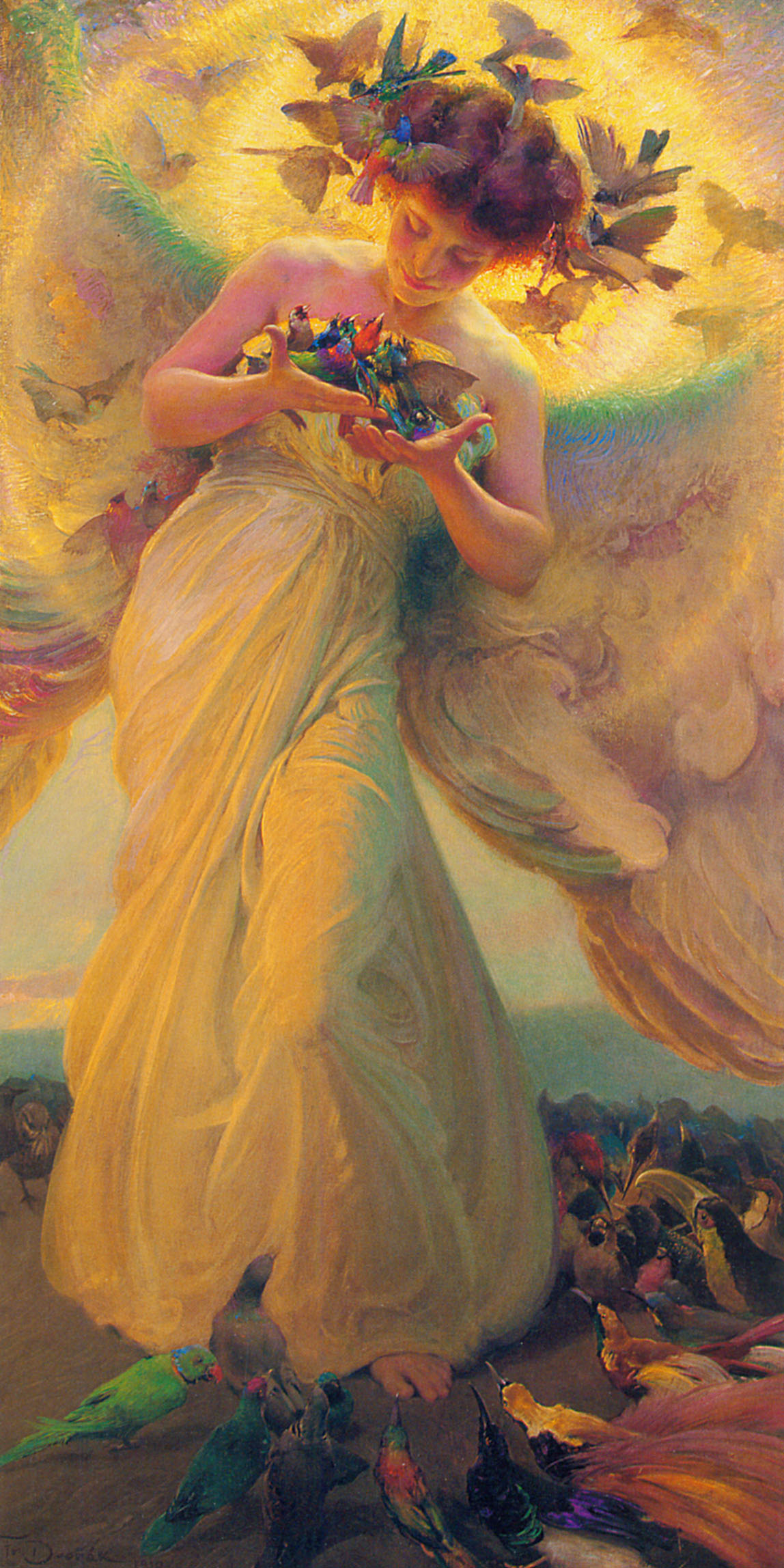
Angel or Demon by Ella Wheeler Wilcox (1850-1919)
You call me an angel of love and of light,
A being of goodness and heavenly fire,
Sent out from God’s kingdom to guide you aright,
In paths where your spirit may mount and aspire.
You say that I glow like a star on its course,
Like a ray from the altar, a spark from the source.
Now list to my answer; let all the world hear it,
I speak unafraid what I know to be true:—
A pure, faithful love is the creative spirit
Which makes women angels! I live but in you.
We are bound soul to soul by life’s holiest laws;
If I am an Angel—why, you are the cause.
As my ship skims the sea, I look up from the deck,
Fair, firm at the wheel shines Love’s beautiful form,
And shall I curse the barque that last night went to wreck,
By the pilot abandoned to darkness and storm?
My craft is no stauncher, she too had been lost—
Had the wheelman deserted, or slept at his post.
I laid down the wealth of my soul at your feet
(Some woman does this for some man every day).
No desperate creature who walks in the street
Has a wickeder heart than I might have, I say,
Had you wantonly misused the treasures you won,
As so many men with heart riches have done.
This fire from God’s altar, this holy love-flame
That burns like sweet incense for ever for you,
Might now be a wild conflagration of shame,
Had you tortured my heart, or been base or untrue.
For angels and devils are cast in one mould,
Till love guides them upward, or downward, I hold.
I tell you the women who make fervent wives
And sweet tender mothers, had Fate been less fair,
Are the women who might have abandoned their lives
To the madness that springs from and ends in despair.
As the fire on the hearth which sheds brightness around,
Neglected, may level the walls to the ground.
The world makes grave errors in judging these things,
Great good and great evil are born in one breast.
Love horns us and hoofs us—or gives us our wings,
And the best could be worst, as the worst could be best.
You must thank your own worth for what I grew to be,
For the demon lurked under the angel in me. (p. 68)
Collected Poems of Ella Wheeler Wilcox (1850-1919). Retrieved October 7, 2022.
https://ia800500.us.archive.org/30/items/poeticalworksofe00wilc/poeticalworksofe00wilc.pdf
Poetical works of Ella Wheeler Wilcox. by Ella Wheeler Wilcox
Edinburgh : W. P. Nimmo, Hay, & Mitchell, 1917.
